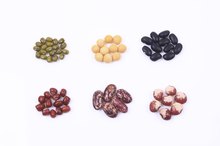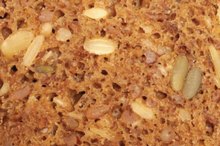Low Amylose Diet Foods
Generally speaking, starches, or carbohydrates, are formed into two molecular structures, usually coexisting in the same food item but at different ratios. One molecule is linear, and it is called amylose. Its bonds are strong, and it takes a lot of energy to break them. The other is a branded structure, loosely bound with hydrogen so it is easier to break apart. It’s called amylopectin. Its weaker chemical bonds make it easy for the body to break down during digestion, releasing it into the bloodstream as glucose. That’s good for athletes and body builders but not advised for diabetics who must be in control of blood sugar levels at all times.
Amylose and the Glycemic Index
Much of the available diet advice, as of 2010, recommends foods with a low glycemic index, or GI. Low GI foods are slow to break down during digestion which slows their release of glucose into the bloodstream. High GI foods are broken down easily, flooding the blood with glucose and inspiring a dramatic insulin response.
There is an inverse relationship between amylose and GI 1. Since the chemical bonds in amylose are stronger than they are in their cousin, amylopectin, they are slower to break. Foods high in amylose concentrations, then, are low on the GI scale. Diabetics should be especially wary of foods low in amylose, though individual reactions can vary.
- Much of the available diet advice, as of 2010, recommends foods with a low glycemic index, or GI.
- Foods high in amylose concentrations, then, are low on the GI scale.
Fruits and Vegetables
Low-Glycemic Foods List
Learn More
Watermelon, grapes and dates are among the fruits with the highest GI, indicating their low amylose content. Most vegetables that grow above ground, like broccoli, cauliflower, lettuces and peppers are very high in amylose. Beats and corn contain the least amount of amylose among vegetables not classified as roots.
Grains
Grains naturally low in amylose include white rice, white flour pasta, cereals made from corn or wheat and breads. Rice cakes and corn or wheat-based crackers are low amylose snacks.
Cooking methods have an impact on the actual GI of a food, however. For example, a pasta low in amylose is cooked in boiling water. The chemical bonds of the abundant amylopectin easily break apart at high temperatures, and it becomes gelatinized, essentially beginning the work of digestion before you even eat it. That makes it even easier for your body to absorb it as glucose, which is to say it raises the GI.
- Grains naturally low in amylose include white rice, white flour pasta, cereals made from corn or wheat and breads.
Roots
List of Slow & Fast Carbs
Learn More
A good general rule is that underground vegetables are low in amylose and thus high in readily available sugars. Carrots and radishes are exceptions. They both have high amylose ratios so they break down more slowly during digestion. High amylose root vegetables include most varieties of potato used for baking or mashing, parsnips and turnips. Sweet potatoes fall right in the middle of the scale, meaning they have both moderate levels of amylose and a corresponding moderate GI of 54.
- A good general rule is that underground vegetables are low in amylose and thus high in readily available sugars.








